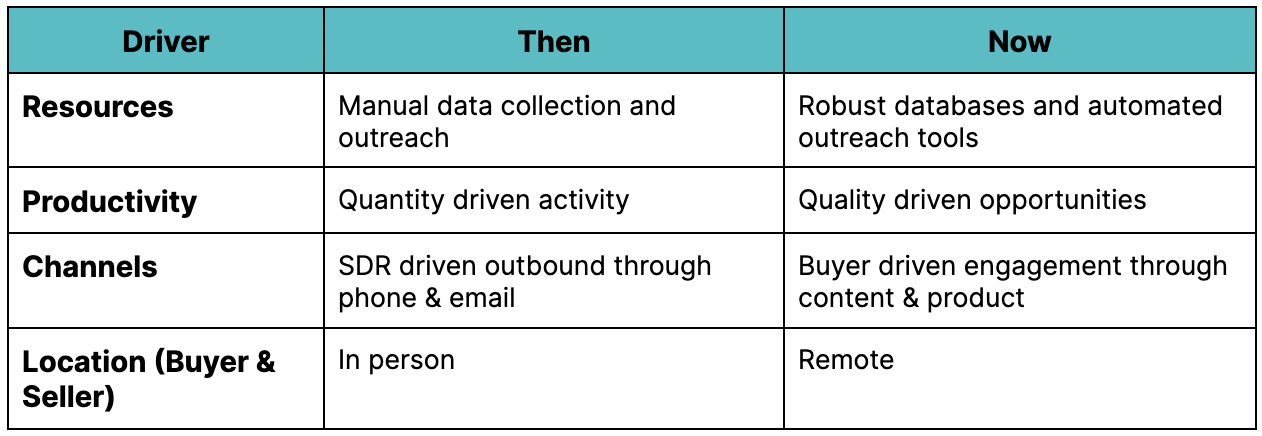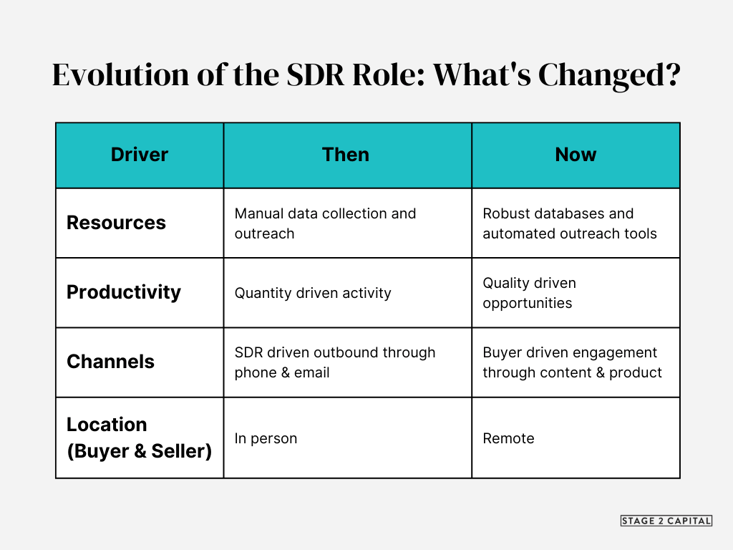There’s been a lot of discussion recently about how AI and ChatGPT can and will disrupt industries. I believe a clear opportunity for disruption in go-to-market is the SDR role.
Think about it — when the modern SDR role was developed twenty years ago, it made a lot of sense. It was a challenge to find prospect data and contact information, so having a different role to basically build a database, contact the buyer and screen/qualify them took that manual work away from AEs. This allowed AEs to spend more time on qualified meetings, which resulted in more closed deals. Email wasn’t saturated, people were answering their phones, and the Internet wasn’t the buying resource it is today. AEs were the most knowledgeable and skilled at selling, so if you doubled or tripled the meetings with an SDR, the payoff worked.
What’s changed?
I am seeing traditional outbound (emails/calls) conversion rates drop across portfolio companies as buyers have become immune to the amount of generic emails and calls they are getting. This means SDRs aren’t getting the same number of quality meetings, which is not only impacting revenue, but also hurting CAC payback. Here’s why:

- Resources: The role of the SDR has evolved from spending a good portion of their time building an accurate database and manually reaching out, to being an outbound machine with the improvement of both accurate data and productivity tools. As tools emerge that also incorporate AI to help with prioritization and automation, the resource constrained problem disappears.
- Productivity: In general, SDRs were focused on hitting activity metrics and contacting a certain number of accounts or buyers based on high-level ICP data collected over time. Because pulling results was manual, the best way to control this was a combination of targeting and activity. However, as better technology has enabled us to score and prioritize accounts/leads, we should be focused on generating quality opportunities, not activity, which is best done by the AE.
- Demand Generation Channels: Cold outreach through email and phone has declined in conversion, but warm outreach, based on buyer intent, is working. Buyers prefer to research, test and engage when they are ready.
- Location: The transition from workplace to remote is also impacting SDR productivity. Sure, phone outreach conversion is down, but so is productivity when you are not surrounded by others to teach and motivate you.
As an example, we have a portfolio company that has an SDR team that sets discovery meetings. Roughly 20% of the meetings SDRs set become qualified opportunities and another 20% of those close. However, when the AE sets a discovery meeting, 45% of those become qualified opportunities and 40% close. The whole point of the SDR role was to get the AE the right amount of qualified opportunities in a cost-efficient way. Which leads me to my next point…
How does AI impact this?
Broader access to AI will fundamentally change the SDR role and the go-to-market team in general. The ability to level up our current tools, where they can accurately prioritize and recommend accounts based on your current customers, help you reach out in a personalized way by finding the data and context, and then convert those into qualified meetings, means that an AE doesn’t necessarily need an SDR. They have an intelligent assistant finding and contacting the right buyers, with the right message, at the right time — and, getting smarter every time they have an interaction.
So, what happens to the SDR role?
The biggest benefit I’ve seen on my SDR teams outside of building pipeline was developing a bench of AE talent. On my last SDR team, when we graduated a SDR to an AE, they were fully productive in the first month. If we see a shift back to full sales cycle AEs that are focused on developing quality opportunities supported by AI technology, does the SDR role go away or does it evolve to something else? I have some ideas — I’d love to hear yours!

